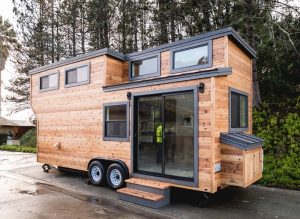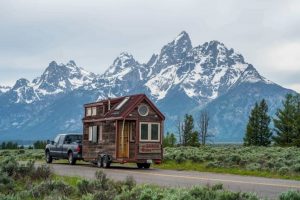In recent years, environmental issues such as climate change, use of pesticides, use of resources, genetic engineering of crops, and others have become increasingly prevalent. To counter these problems other movements have cropped up. The organic food industry is in response to increasing concern about pesticides and GMOs. In the same way, the tiny house movement arose partially as a way to combat the unnecessary overuse of resources in modern lifestyles while providing financial independence, freedom, and often mobility.
 Historically, homes and personal spaces have not been large. But around the 1960s, the size of American homes ballooned and continues to grow even now. In 1950 the average size of a new, single-family home was 983 sq. feet, in 1973 it had become 1660 sq. feet, and by 2015 it was 2598 sq. feet (Kilman, 2016; McLennan, 2010). For many, the sheer amount of space is unnecessary and uses many resources that would be better used elsewhere or conserved, such as the labor that goes into the building process, gas and energy being used as power, material resources, and time. These resources, combined with the size of a home, amount to a heavy bill and cause financial strain. This means that homeowners will spend more time trying to cover their bills month to month than saving or using their money for personal enjoyment and gain. This is why people have started to move in the opposite direction with their housing; they are choosing to go back to their roots and not live beyond their means.
Historically, homes and personal spaces have not been large. But around the 1960s, the size of American homes ballooned and continues to grow even now. In 1950 the average size of a new, single-family home was 983 sq. feet, in 1973 it had become 1660 sq. feet, and by 2015 it was 2598 sq. feet (Kilman, 2016; McLennan, 2010). For many, the sheer amount of space is unnecessary and uses many resources that would be better used elsewhere or conserved, such as the labor that goes into the building process, gas and energy being used as power, material resources, and time. These resources, combined with the size of a home, amount to a heavy bill and cause financial strain. This means that homeowners will spend more time trying to cover their bills month to month than saving or using their money for personal enjoyment and gain. This is why people have started to move in the opposite direction with their housing; they are choosing to go back to their roots and not live beyond their means.
Building a tiny home can be complex depending on the homeowners’ locality. Most places have zoning laws that prohibit buildings under a certain square footage, normally done by county: “the minimum single-family residence size in Gwinnett County, GA is 1,400 sq. ft” (Kilman, 2016). As a result, the movement predominantly features tiny homes on wheels, which are classed as RVs. Going this route, the homeowners would also not pay property tax. With both more money in the bank and a home that could be pulled by a decently sized truck, many choose to travel. Taking a tiny home on the road has its own considerations. For instance, there are laws surrounding both the dimensions of the trailer and its weight, as either a permit or a different class of vehicle may be needed for a homeowner to tow the tiny house themselves. Most roads are about 9 feet wide for a single lane the general limit on height is 13.5 feet, and a tiny home should be built with this in consideration.
With the general restrictions on dimension, most tiny homes are around 180 sq. feet. The size is wonderful for utilities; the average monthly electric bill runs about $114, which can amount to a lot of savings (Lake, 2016). But the small space also requires some creative solutions to utilize, and because many of the movement’s adherents show environmental concern, some curious mashups have occurred. In the interest of conserving water, both toilets and miniature washing machines have been created with sinks in the top, so the water used in washing hands drains into the attached reservoir. Other space saving solutions are stairs that double as shelving, a trundle-style bed that disappears under a lifted kitchen floor and doubles as a couch, tables that fold down from the wall and hold spices or function as a mirror when upright, couches that can also be a bed or storage unit, cabinets in the floor for extra storage, shoe racks underneath chairs, and wet baths, where the entire bathroom becomes a shower.
The freedom a tiny home provides, both financial and in mobility, begs homeowners to venture out and experience. Why not, when you can avoid the costs of a hotel and just bring your house with you? Many people decide to go tiny specifically because they decide to put emphasis on experience rather than material goods and this lifestyle allows them to spend less time working and more time doing the things they love. Seems like sound reasoning to me. So take life by the reins, go tiny.

-Mikaela Williams
References
Code-Friendly Fresno’s California Tiny House Company – Tiny House Blog. (n.d.). Retrieved February 2, 2018, from http://tinyhouseblog.com/uncategorized/code-friendly-fresnos-california-tiny-house-company/
Kilman, C. (2016). Small House, Big Impact: The Effect of Tiny Houses on Community and Environment. Undergraduate Journal of Humanistic Studies @BULLET Winter, 2, 12. Retrieved from https://pdfs.semanticscholar.org/2732/8c4ba21b4f6ae467210ddffd3edb2da8fa4b.pdf
Lake, R. (2016). How Much Can You Save By Living in a Tiny Home? – SmartAsset. Retrieved February 2, 2018, from https://smartasset.com/mortgage/how-much-can-you-save-by-living-in-a-tiny-home
McLennan, J. F. (2010). The Righteous Small House: Challenging House Size and the Irresponsible American Dream. Retrieved February 2, 2018, from http://www.yesmagazine.org/planet/the-righteous-small-house-challenging-house-size-and-the-irresponsible-american-dream
Tiny House Weight: How to Calculate and Weigh a Tiny Home for Towing. (2017). Retrieved February 2, 2018, from https://tinyhousegiantjourney.com/2017/01/26/tiny-house-weight/